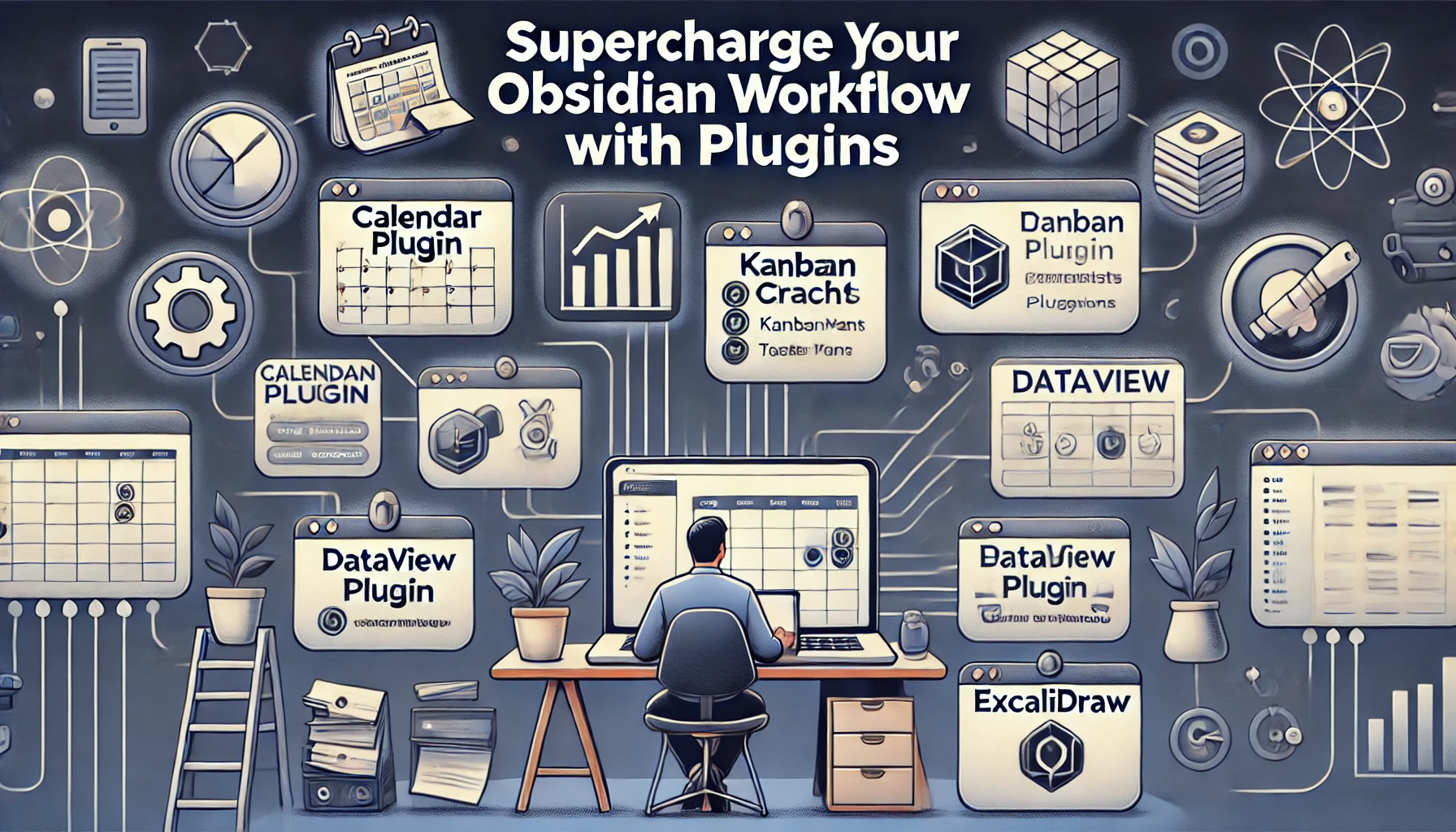Unlocking the Power of Plugins in Obsidian
 Himanshu Nikhare
Himanshu Nikhare
Introduction
Obsidian is a powerful tool on its own, but its real strength comes from the vast library of plugins available. Plugins allow you to tailor your Obsidian experience to suit your specific needs, whether you're managing projects, writing, or building a personal knowledge base. In this episode, we'll explore some of the most essential plugins that can take your Obsidian workflow to the next level.
Step 1: Installing Plugins
Obsidian offers two types of plugins: Core Plugins and Community Plugins.
Enabling Core Plugins:
Core Plugins are built-in features of Obsidian. You can enable or disable them based on your needs.
Go to Settings > Core Plugins.
Toggle on the plugins you want to use, such as Daily Notes, Templates, and Backlinks.
Installing Community Plugins:
Community Plugins are developed by the Obsidian community and can be installed from the marketplace.
Go to Settings > Community Plugins > Browse.
Search for the plugins you want, install them, and click Enable.
Step 2: Must-Have Plugins for Productivity
Here’s a list of some of the most useful plugins you can integrate into your Obsidian setup:
Dataview:
Description: Dataview allows you to query your notes and present the information in tables, lists, or calendar views. It’s perfect for displaying data such as tasks, deadlines, or research.
Use Case: Track all notes tagged with
#taskor#researchand display them in an easily viewable format.
Calendar Plugin:
Description: The Calendar Plugin gives you a visual calendar to navigate your daily notes, making it easy to track progress over time.
Use Case: Quickly view and manage your daily notes from a calendar interface. You can create future notes and plan ahead as well.
Kanban Plugin:
Description: This plugin helps you organize your tasks visually using a Kanban board. You can easily track tasks through different stages like “To Do,” “In Progress,” and “Completed.”
Use Case: Manage tasks or projects by creating columns for different stages, and move tasks through the workflow with drag and drop functionality.
Templater:
Description: Templater is a more advanced template manager than the default Templates plugin. It allows you to create dynamic templates with variables, which can significantly speed up your note creation process.
Use Case: Create dynamic templates for meeting notes, daily logs, or research. You can automatically generate dates, titles, and other fields with this plugin.
Excalidraw:
Description: Excalidraw is a powerful drawing tool integrated into Obsidian. It allows you to create hand-drawn-style diagrams directly in your notes.
Use Case: Use Excalidraw for brainstorming, mind mapping, or creating visual models for projects and ideas.
QuickAdd:
Description: QuickAdd allows you to quickly add notes, tasks, or templates with a simple command. This is useful for capturing ideas or tasks without breaking your workflow.
Use Case: Use it to capture tasks or meeting notes on the fly without needing to manually create new notes.
Task Plugin:
Description: The Task Plugin extends the functionality of Obsidian’s built-in task system, allowing you to add due dates, recurring tasks, and filters.
Use Case: Manage your tasks with due dates and filters, and track recurring tasks easily within your notes.
Advanced Tables:
Description: This plugin simplifies the creation of tables in Markdown, making it easier to format and edit tables directly within your notes.
Use Case: Create well-organized tables for tracking tasks, research, or project data without dealing with complex Markdown syntax.
Periodic Notes:
Description: This plugin is perfect for journaling or keeping track of notes on a daily, weekly, or monthly basis. It automates the creation of daily, weekly, and monthly notes.
Use Case: Automate your journaling or project tracking with a system that generates new notes for specific time periods.
Natural Language Dates:
Description: This plugin allows you to use natural language to create dates in your notes. You can type phrases like "next Monday" or "in 3 days" and Obsidian will convert them to actual dates.
Use Case: Quickly set task due dates or create reminders using natural language.
Step 3: Enhancing Workflow with More Plugins
Here are a few more plugins that can add significant value to your workflow:
- Obsidian Git:
Description: This plugin lets you sync your notes with a Git repository. Perfect for users who want to version-control their notes or collaborate with others.
Use Case: Sync your notes across devices using Git, providing an automatic backup and version control system.
- Hover Editor:
Description: This plugin allows you to preview and edit notes in a popup window without navigating away from your current note.
Use Case: Quickly check and edit linked notes without interrupting your flow.
- Omnisearch:
Description: Omnisearch adds powerful search functionality to Obsidian, enabling you to search within all your notes more efficiently.
Use Case: Quickly find notes, keywords, or tags using advanced search features across your entire vault.
- Workspaces:
Description: Workspaces lets you save and restore specific layouts in Obsidian, allowing you to switch between different workflows (such as research mode or writing mode) with ease.
Use Case: Create different workspaces for writing, task management, or research, and switch between them depending on what you’re working on.
Step 4: Managing Plugins Efficiently
To make sure your Obsidian experience stays smooth and fast, it’s important to manage your plugins wisely:
Deactivate Unused Plugins:
- If you don’t need certain plugins anymore, disable or uninstall them to keep Obsidian running smoothly.
Update Plugins Regularly:
- Go to the Community Plugins section and check for updates to keep your plugins up-to-date and working efficiently.
Step 5: Advanced Use - Building Custom Plugins
For developers or power users, Obsidian allows you to create your own custom plugins:
Getting Started:
- Use TypeScript or JavaScript to build your own custom plugins by utilizing the Obsidian API.
Custom Use Cases:
- If you need specific workflows or integrations, building a custom plugin may be the perfect solution for automating tasks or adding specialized features.
Conclusion
Plugins are what make Obsidian incredibly versatile, allowing you to turn it into a productivity powerhouse. From task management and visual calendars to advanced note querying, the range of plugins lets you customize Obsidian to suit your workflow. Whether you’re writing, researching, or managing projects, there’s a plugin to enhance your experience.
In the next episode, we’ll explore how to turn Obsidian into your personal wiki, creating a fully interconnected knowledge base. Stay tuned for more!
Subscribe to my newsletter
Read articles from Himanshu Nikhare directly inside your inbox. Subscribe to the newsletter, and don't miss out.
Written by

Himanshu Nikhare
Himanshu Nikhare
I am a Senior Software Engineer at BigBasket with over three years of experience in software development. Specializing in QA automation, CI/CD, and mobile automation, I am passionate about creating efficient workflows and sharing knowledge through blogs and articles. I actively contribute to the tech community through my work, open-source projects, and insightful content. Feel free to connect with me on GitHub or LinkedIn to explore my projects and contributions.